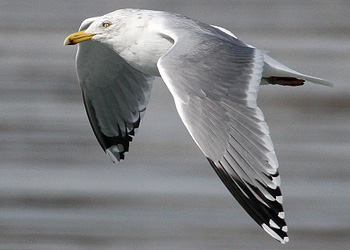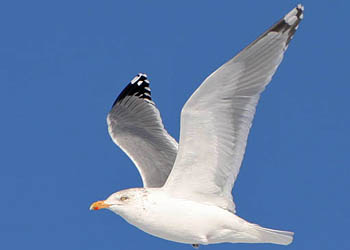 American Herring Gull (smithsonianus)
American Herring Gull (smithsonianus)
(last update: October 30, 2015)
American Herring Gull 4cy June
The Peterson Reference Guides
GULLS OF THE AMERICAS
- Steve N.G. Howell / Jon Dunn -
Below is a copy of chapter 25 about American Herring Gull, illustrated with images from this website. "we" in the text below refers to the original authors. If any errors occur in this text, please let me know and mail to marsmuusseatgmaildotcom.
American Herring Gull (smithsonianus)
PART 1: IDENTIFICATION SUMMARY
PART 2: FIELD IDENTIFICATION - ADULT CYCLE
PART 3: FIELD IDENTIFICATION - FIRST CYCLE
PART 4: FIELD IDENTIFICATION - SECOND & THIRD CYCLE
PART 5: RARER SPECIES
PART 6: DESCRIPTION & MOLT IN ADULT CYCLE (BELOW)
DESCRIPTION & MOLT
Molts of migrants in w. N. America average up to a month or so later than those of populations breeding in e. N. America (HoweIl pers. obs.). Some average plumage differences within populations also occur, at least in first-cycle birds. We discuss these differences below under so-called West Coast types and East Coast types, while recognizing that this simplifies the distribution of the plumage types; more study is needed on patterns of plumage variation in American Herring Gulls. Based on specimens, birds breeding on the Great Lakes and the New England coast average slightly paler (nearer Kodak 4-5; n = 20) than Alaska breeders and birds wintering in Calif. (nearer Kodak 5; n = 30), but such differences not likely to be noticeable in the field.
Adult Cycle.
Complete PB molt (June/July-Nov./Jan.) produces adult basic plumage: head, neck, and underparts white; head, neck, and sometimes upper chest with variable (usually moderate to heavy) dusky streaking and mottling. Upperparts pale gray (Kodak 4-5) with black wingtips (black on outer web of P10 and sometimes P9 extends to primary coverts; P4 sometimes with limited black); white scapular and tertial crescents; and white tips to outer primaries. Uppertail coverts and tail white. White trailing edge to secondaries (often hidden at rest) and inner primaries breaks into discrete white tips on outer primaries; P5-P8 typically have narrow white tongue-tips and black subterminal bands, and P10 has distinct white mirror; P10 mirror largest on ne. coastal populations, and these also often have a P9 mirror rarely seen on West Coast migrants. (Jonsson and Mactavish 2001; Macpherson 1961) Birds wintering in e. Canada also average less black in wingtips than those wintering on Great Lakes (Jonsson & Mactavish 2001) and in w. N. America. (Howell pers. obs.) Underwings typically show blackish wingtips (with P10 or P9-P10 mirrors, white tongue-tips out to P8) cleanly demarcated from pale gray, white-tipped inner primaries and secondaries; however, some birds in e. Canada have relatively washed-out underside to wingtip. Eyes staring pale lemon (rarely flecked dusky, especially in the West, (Howell pers. obs.) and exceptionally dull olive; perhaps indicating hybridism?), orbital ring orange to yellow-orange (can be dark gray in winter and pinkish in transition). Bill yellow (often pinkish to greenish basally in winter) with orange-red to red gonydeal spot and, in winter, often a dark distal band. Legs flesh pink, often paler during later stages of PB molt. Partial PA molt (Oct.-Mar./Apr.) produces adult alternate plumage: head and neck clean white (usually by Feb./Mar. on East Coast, by Mar./Apr. on West Coast); white primary tips can be lost through wear. By spring, orbital ring yellow-orange to reddish orange, legs brighter flesh pink (becoming lemon yellow on some birds during at least Mar-Apr. (Howell pers. obs.)), bill bright lemon yellow with red gonydeal spot, lacking dark distal marks.
East coast birds
 American Herring Gull (smithsonianus) sub-adult N22 June 30 2010, Jenness Beach - Rye, NH. Picture: Lauren Kras.
American Herring Gull (smithsonianus) sub-adult N22 June 30 2010, Jenness Beach - Rye, NH. Picture: Lauren Kras. American Herring Gull (smithsonianus) R03 4CY, June 22 2015, Newcastle Commons, NH. Picture: Robbie Prieto.
American Herring Gull (smithsonianus) R03 4CY, June 22 2015, Newcastle Commons, NH. Picture: Robbie Prieto. American Herring Gull (smithsonianus) 4cy, June 01 2007, Nova Scotia, Canada.
American Herring Gull (smithsonianus) 4cy, June 01 2007, Nova Scotia, Canada.Great Lakes birds
 American Herring Gull (smithsonianus) 3rd cycle (4CY) xxxx-xxxxx June 06 2015, Manitowoc, IL. Picture: Amar Ayyash.
American Herring Gull (smithsonianus) 3rd cycle (4CY) xxxx-xxxxx June 06 2015, Manitowoc, IL. Picture: Amar Ayyash. American Herring Gull (smithsonianus) sub-adult, June 06 2015, Manitowoc, IL. Picture: Amar Ayyash.
American Herring Gull (smithsonianus) sub-adult, June 06 2015, Manitowoc, IL. Picture: Amar Ayyash.










